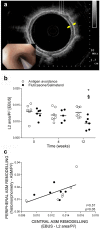Fluticasone/salmeterol reduces remodelling and neutrophilic inflammation in severe equine asthma
- PMID: 28821845
- PMCID: PMC5562887
- DOI: 10.1038/s41598-017-09414-8
Fluticasone/salmeterol reduces remodelling and neutrophilic inflammation in severe equine asthma
Abstract
Asthmatic airways are inflamed and undergo remodelling. Inhaled corticosteroids and long-acting β2-agonist combinations are more effective than inhaled corticosteroid monotherapy in controlling disease exacerbations, but their effect on airway remodelling and inflammation remains ill-defined. This study evaluates the contribution of inhaled fluticasone and salmeterol, alone or combined, to the reversal of bronchial remodelling and inflammation. Severely asthmatic horses (6 horses/group) were treated with fluticasone, salmeterol, fluticasone/salmeterol, or with antigen avoidance for 12 weeks. Lung function, central and peripheral airway remodelling, and bronchoalveolar inflammation were assessed. Fluticasone/salmeterol and fluticasone monotherapy decreased peripheral airway smooth muscle remodelling after 12 weeks (p = 0.007 and p = 0.02, respectively). On average, a 30% decrease was observed with both treatments. In central airways, fluticasone/salmeterol reversed extracellular matrix remodelling after 12 weeks, both within the lamina propria (decreased thickness, p = 0.005) and within the smooth muscle layer (p = 0.004). Only fluticasone/salmeterol decreased bronchoalveolar neutrophilia (p = 0.03) to the same extent as antigen avoidance already after 8 weeks. In conclusion, this study shows that fluticasone/salmeterol combination decreases extracellular matrix remodelling in central airways and intraluminal neutrophilia. Fluticasone/salmeterol and fluticasone monotherapy equally reverse peripheral airway smooth muscle remodelling.
Conflict of interest statement
The authors declare that they have no competing interests.
Figures







Similar articles
-
Corticosteroids and antigen avoidance decrease airway smooth muscle mass in an equine asthma model.Am J Respir Cell Mol Biol. 2012 Nov;47(5):589-96. doi: 10.1165/rcmb.2011-0363OC. Epub 2012 Jun 21. Am J Respir Cell Mol Biol. 2012. PMID: 22721832
-
Acute effects of salmeterol and fluticasone propionate alone and in combination on airway blood flow in patients with asthma.Chest. 2012 May;141(5):1184-1189. doi: 10.1378/chest.11-0685. Epub 2011 Oct 6. Chest. 2012. PMID: 21980058 Clinical Trial.
-
Inhaled salmeterol/fluticasone propionate combination: a review of its use in persistent asthma.Drugs. 2000 Nov;60(5):1207-33. doi: 10.2165/00003495-200060050-00012. Drugs. 2000. PMID: 11129128 Review.
-
Inhaled salmeterol and fluticasone: a study comparing monotherapy and combination therapy in asthma.Ann Allergy Asthma Immunol. 1999 Mar;82(3):257-65. doi: 10.1016/S1081-1206(10)62606-3. Ann Allergy Asthma Immunol. 1999. PMID: 10094216 Clinical Trial.
-
Inhaled salmeterol/fluticasone propionate combination: a pharmacoeconomic review of its use in the management of asthma.Pharmacoeconomics. 2003;21(13):951-89. doi: 10.2165/00019053-200321130-00004. Pharmacoeconomics. 2003. PMID: 12959627 Review.
Cited by
-
A CONSORT-guided, randomized controlled clinical trial of nebulized administration of dexamethasone and saline on lower airway cytokine mRNA expression in horses with moderate asthma.J Vet Intern Med. 2024 Mar-Apr;38(2):1214-1223. doi: 10.1111/jvim.16983. Epub 2024 Jan 11. J Vet Intern Med. 2024. PMID: 38205666 Free PMC article.
-
Equine asthma: Integrative biologic relevance of a recently proposed nomenclature.J Vet Intern Med. 2018 Nov;32(6):2088-2098. doi: 10.1111/jvim.15302. Epub 2018 Oct 7. J Vet Intern Med. 2018. PMID: 30294851 Free PMC article. Review.
-
One stone two birds: anti-inflammatory bronchodilators as a potential pharmacological strategy for COVID-19.Front Pharmacol. 2023 May 4;14:1185076. doi: 10.3389/fphar.2023.1185076. eCollection 2023. Front Pharmacol. 2023. PMID: 37214443 Free PMC article. Review.
-
Severe asthma is associated with a remodeling of the pulmonary arteries in horses.PLoS One. 2020 Oct 22;15(10):e0239561. doi: 10.1371/journal.pone.0239561. eCollection 2020. PLoS One. 2020. PMID: 33091038 Free PMC article.
-
A Retrospective Study Evaluating Asthma Control in Patients on Fluticasone Propionate/Salmeterol Proactive Regular Dosing with a History of Uncontrolled Asthma.Pulm Ther. 2025 Mar;11(1):25-40. doi: 10.1007/s41030-024-00278-8. Epub 2024 Nov 9. Pulm Ther. 2025. PMID: 39520649 Free PMC article.
References
Publication types
MeSH terms
Substances
Grants and funding
LinkOut - more resources
Full Text Sources
Other Literature Sources
Medical

